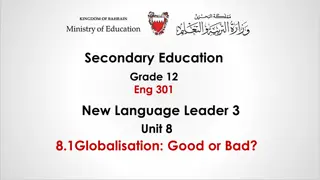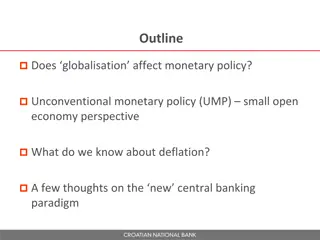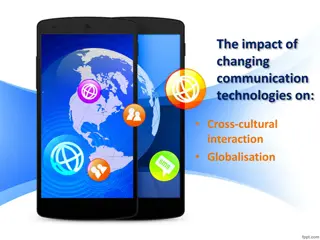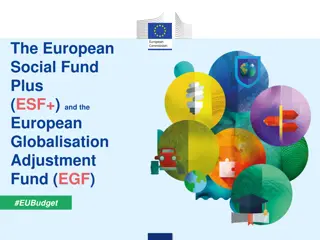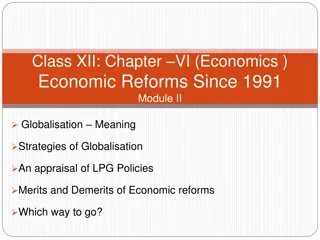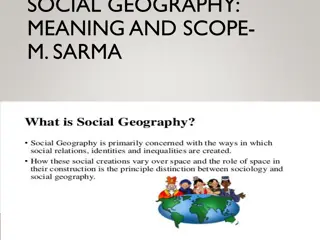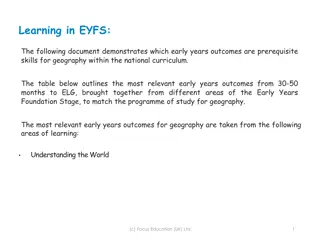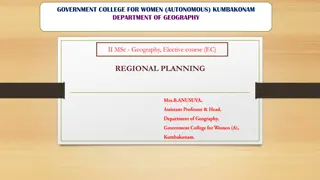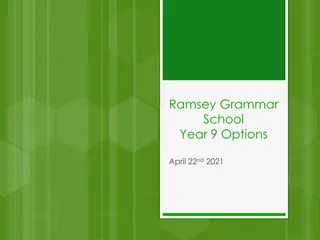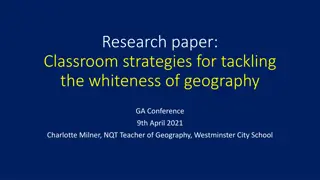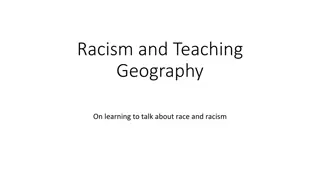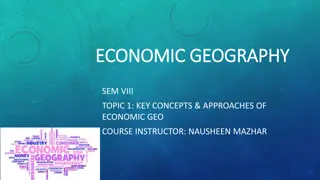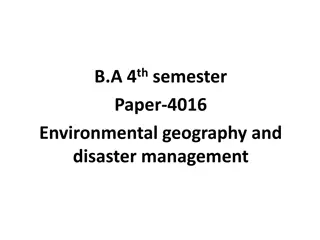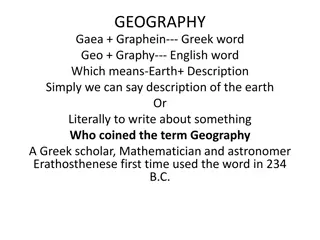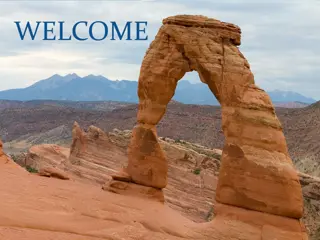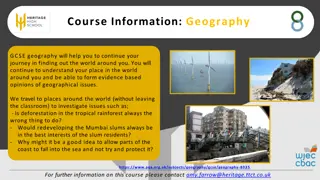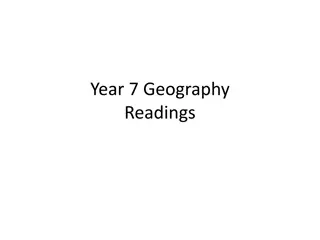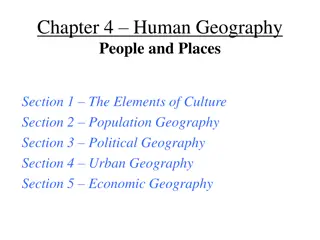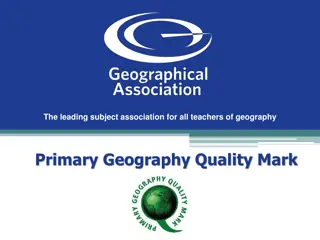Understanding Globalisation: Lessons for Year 8 Geography Students
The readings introduce students to the concept of globalisation, highlighting its impact on various aspects such as culture, economy, environment, geography, politics, religion, society, and technology. Students learn about the interdependence among individuals and communities globally and how globalisation affects them personally. The lessons also discuss the rapid growth and influence of large transnational businesses, shaping cultures and influencing young people to become informed and responsible global citizens.
Download Presentation

Please find below an Image/Link to download the presentation.
The content on the website is provided AS IS for your information and personal use only. It may not be sold, licensed, or shared on other websites without obtaining consent from the author. Download presentation by click this link. If you encounter any issues during the download, it is possible that the publisher has removed the file from their server.
E N D
Presentation Transcript
Year 8 Geography Readings
Year 8 Geog Globalisation Lesson 1 Reading Activity Inroduction to Globalisation 1. Write down the heading. ____________________________________________________________________ 2. What do you think this piece of writing is about?_________________________________________________ 3. Is it descriptive, informative or persuasive?_____________________________________________________ 4. Read the piece of writing and circle any words whose meaning you are not sure of. 5. Underline the following words: consumerism, countries, cultural, economic, environmental, geographical, globalisation, political, religious, social, spatial, technological 6. What does a study of globalisation provide? __________________________________________________________ _____________________________________________________________________________________________ 7. What features does this interdependence have? _______________________________________________________ ______________________________________________________________________________________________ _____________________________________________________________________________________________ 8. How do you think globalisation affects you? __________________________________________________________ _____________________________________________________________________________________________ _____________________________________________________________________________________________ The study of globalisation The study of globalisation provides opportunities for students to identify and explore the ways that individuals and communities increasingly depend on each other. They recognise that interdependence has a number of features: cultural (e.g. arts, media, advertising, food, sport) economic (e.g. global consumerism; changing patterns of trade, investment and debt; struggle for development and human rights; development cooperation) environmental (e.g. global climate change, energy security, pollution, population growth, species conservation, protection of oceans) geographical (e.g. the spatial interactions between people and places and how they changeover time the growth of urban areas; resource distribution, use and management) political (e.g. international governance; bilateral and multilateral relationships; peace and security issues; regional and global governance; civil rights) religious (e.g. values, fundamentalism; interfaith cooperation) social (e.g. multiculturalism, migration, tourism, education, public health, people-to-people links) technological (e.g. impact of new technologies in different communities and countries; global communications and the movement of goods; the digital divide).
Year 8 Geog Globalisation Lesson 2 Reading Activity - Globalisation 1. Write down the heading. ____________________________________________________________________ 2. What do you think this piece of writing is about?_________________________________________________ 3. Is it descriptive, informative or persuasive?_____________________________________________________ 4. Read the piece of writing and circle any words whose meaning you are not sure of. 5. Underline the following words: borderless , communicate, globalisation, influence, overseas, rapid, transnational, web 6. Is Globalisation new? __________________________________________________________________________ 7. How has it changed in recent years?_______________________________________________________________ 8. How are you a global citizen? _____________________________________________________________________ ______________________________________________________________________________________________ ______________________________________________________________________________________________ Globalisation recent years the globalisation process has been rapid and widespread. One of the results has been the growth in large businesses that produce and sell goods in many countries. These businesses have a large influence on cultures all around the world. For example young people wear international brand clothes, eat fast food from other countries, watch films made overseas and listen to overseas bands. At the same time they have become informed, responsible active citizens influencing decision making at the local to the global scale. Today globalisation is like a web. This means that no matter how far apart we are geographically, we are all held together as members of the human race. It is like we are moving toward a borderless world. Globalisation brings people all over the world closer together. Goods, ideas, money, services and people move between countries. An idea that once took years to spread around the world, now takes seconds. Today people communicate instantly with their friends across the world by email and mobile phone and travel to other countries in the fast A380 airbus. On the Internet, Google Earth enables people to visit exciting places on the other side of the Earth with a tap on the computer keys. Large companies, called transnational corporations (TNCs) produce goods in most countries and farmers sell their produce almost anywhere in the world. Although globalisation is not new people, goods, money and ideas have moved around the world for centuries. In
Year 8 Geog Globalisation Lesson 3 Reading Activity - Changes in technology 1. Write down the heading. ____________________________________________________________________ 2. What do you think this piece of writing is about?_________________________________________________ 3. Is it descriptive, informative or persuasive?_____________________________________________________ 4. Read the piece of writing and circle any words whose meaning you are not sure of. 5. Underline the following words: satellite, technologies, vehicles 6. Who owns TracerTrak? ________________________________________________________________________ 7. What does it do?_____________________________________________________________________________ 8. How would this help the globalisation of our world? ____________________________________________________ _____________________________________________________________________________________________ Tracking technology boosts Bris-Giadstone New tracking technologies have helped the Brisbane to Gladstone Yacht Race reach a larger international audience as its website recorded more than 1.6 million hits over the Easter weekend. The 64-yacht field was fitted with the cutting edge satellite tracking service, named TracerTrak, which enabled fans to track the yachts on a map on the race's official website. The sponsorship deal with TracerTrak owners, Pivotel Group, led to about 1.6 million hits on the race website, a major leap above last year's record of 80 000 in total. Of the 1.6 million hits, more than 300 000 were from unique users, representing the total amount of people who used the internet to monitor the race. The TracerTrak service, more usually applied to trucks and commercial vehicles, uses a satellite tracking unit, which regularly sends updates to the Globalstar constellation of 40 low earth orbit satellites. The location and behaviour of the asset are then reported to a map that can be updated at intervals as short as two minutes apart. Plain sailing Pivotel Group managing director Peter Bolger said the partnership was an enormous success and highlighted the tracking abilities of the service. 'The fantastic thing about the integration of the internet into the TracerTrak service is that it allows people to track or monitor assets from anywhere that the Internet is accessible,' said Mr Bolger. 'The event organisers had emails coming from people in places like Canada and Honolulu who were following the fleet through the TracerTrak system. 'The event was the perfect way to give people a sample of what the TracerTrak can do when it is applied to boats and other vehicles. Queensland Cruising Yacht Club Commodore lan Gidlow said the satellite yacht tracking was a real coup for the 60th anniversary of the race. 'We were thrilled to have Pivotel TracerTrak devices fitted to every yacht and be able to enable people from around the globe to track the fleet in real time,' Mr Gidlow said. Mr Bolger said that tracking was only one component of the 'versatile and cutting-edge technology'. 'With TracerTrak you can predefine areas so that if the asset leaves those boundaries, an alarm is sent via email or SMS to your phone,' said Mr Bolger. 'These sorts of features are great not just for the consumers wanting the added security for their boat, but also for commercial markets. Some of the major clients of TracerTrak are logistics companies wanting to have the ability to monitor vital business assets such as shipping containers and trucks. With satellite coverage extending well out into the oceans surrounding Australia, such as the islands of Vanuatu and Noumea and up through PNG, the traditional tracking limitations of cellular networks are a thing of the past.'
Year 8 Geog Globalisation Lesson 4 Reading Activity - Changes in communications 1. Write down the heading. ____________________________________________________________________ 2. What do you think this piece of writing is about?_________________________________________________ 3. Is it descriptive, informative or persuasive?_____________________________________________________ 4. Read the piece of writing and circle any words whose meaning you are not sure of. 5. Underline the following words: broadband, communication, data, digital, geostationary, information, network, wireless 6. What is the best way to handle the large flows of information? ___________________________________________ 7. What are geostationary satellites? ________________________________________________________________ ______________________________________________________________________________________________ 8. Why do you think Antarctica is not connected by fibre optic cable? _________________________________________ ______________________________________________________________________________________________ __________________________________________________________________________________________ THE FIBRE OPTIC CABLE NETWORK One fibre optic cable is as thin as a human hair and is able to carry large amounts of digital information over very long distances. Fibre optic cables are the best method of handling the high volume of phone calls and information flows between different places all over the globe. The fibre optic cables that are laid around the world are made up of thousands of individual cables. A huge network of these cables connects the world s major cities. They have enabled the development of the telephone, cable television and Internet network that we have today. The network is laid on land and on the sea floor across most of the world s oceans. The only continent not connected by fibre optic cable is Antarctica. A recent advance in communication technology is the growth in broadband technology. Digital files are sent through telephone lines, fibre optic cables, wireless networks and satellites. The future challenge for the optical fibre cable network will be to increase the amount of data that can be transmitted through the cables as the size of the files increases and more of the world s population use the network. Broadband has all but replaced dial-up Internet accounts because it is faster and can handle large amounts of information. SATELLITE COMMUNICATIONS With the development of the first wireless technology at the end of the nineteenth century came the difficulty of sending these communication signals over long distances. As signals do not bend along the Earth s curved surface, satellites were developed to overcome this problem. They are able to record and send information as they orbit high above the earth. Today, there are hundreds of satellites in operation around the world. These satellites are used for communications, weather forecasting, television broadcasting, radio communications, Internet access and defence, as well as other things, such as global positioning systems (GPS). Most communication satellites in use today are in a geostationary orbit. This means that the satellite remains over the same position of the Earth s surface and stays fixed in the sky from any point on Earth. Geostationary satellites can be spaced at intervals of up to 120 degrees longitude. In this way as few as three satellites are able to link all the inhabited regions of the world, providing an effective global communications network. Satellites are the best method of mobile communications for ships and planes as well as for people who are in areas that lack good communication networks.
Year 8 Geog Globalisation Lesson 5 Reading Activity - Changes in television 1. Write down the heading. ____________________________________________________________________ 2. What do you think this piece of writing is about?_________________________________________________ 3. Is it descriptive, informative or persuasive?_____________________________________________________ 4. Read the piece of writing and circle any words whose meaning you are not sure of. 5. Underline the following words: absorbs, adapts, boundaries, indigenous, local content, media giants, Western, world, 6. What culture does globalisation tend to spread? _______________________________________________________ 7. Why is that? _________________________________________________________________________________ ______________________________________________________________________________________________ 8. What do you think is best? Local culture or a world culture?______________________________________________ ______________________________________________________________________________________________ ______________________________________________________________________________________________ Globalisation and television Culture changes over time as it adapts to and absorbs external influences. Globalisation is affecting the culture of indigenous and national peoples in all parts of the world. Globalisation tends to spread Western culture, particularly American culture. Many people are concerned that local cultures are being edged out and might eventually disappear. Others think that cultural integration is a good thing and look forward to the development of a world culture. The Internet, satellites and cable TV have swept away cultural boundaries. Information and entertainment can now be flashed around the world in seconds. However, control of the media is concentrated in the hands of a few media giants such as Time Warner, Disney and News Corporation. Their control and influence extends into film production, book publishing, music, television, retail stores, amusement parks, magazines and newspapers. In Australia, broadcasting networks must abide by rules that lay down the amount of `local content that is, Australian-made productions. shown on TV. The aim as stated in the Broadcasting Services Act is to `promote the role of broadcasting services in developing and reflecting a sense of Australian identity, character and cultural diversity'. Some fear that, without these content rules, the local film and broadcasting industry will collapse and Australian culture will be overwhelmed by Americanisms. owned by Sir Keith Murdoch. His son Rupert Murdoch, who succeeded him, is now the Chief Executive Officer (CEO) of News Corporation. Murdoch has created a global media empire based in the Asia Pacific, North America and Europe, using the very latest in computer, cable and satellite technology. The major activities of this global media enterprise include printing and publishing newspapers, magazines and books, television broadcasting and motion picture production and distribution. In summary, News Corporation has been a highly successful transnational corporation. In June 2006, the company s total assets were US$56 billion, with a net profit (after tax) of US$2.3 billion. There are over 50 000 employees of News Corporation spread around the world. News Corporation is a true global media company, involved in the production of films, television, newspapers, magazines and books. It is still searching for new opportunities and using new technologies. News Corporation (or NewsCorp) had humble beginnings in Australia as the Adelaide Advertiser, a newspaper
Year 8 Geog Globalisation Lesson 6 Reading Activity - Changes in transportation 1. Write down the heading. ____________________________________________________________________ 2. What do you think this piece of writing is about?_________________________________________________ 3. Is it descriptive, informative or persuasive?_____________________________________________________ 4. Read the piece of writing and circle any words whose meaning you are not sure of. 5. Underline the following words: cargo, containers, passengers, shipping, supertanker, technological, trade 6. What is international shipping? ___________________________________________________________________ _____________________________________________________________________________________________ 7. What technological advances have increased air and sea transportation? _____________________________________ _____________________________________________________________________________________________ 8. What sorts of goods do you think would be transported by sea rather than air? ________________________________ _____________________________________________________________________________________________ _____________________________________________________________________________________________ Changes in transportation Sea Transport International shipping involves the movement of goods between countries. The type and volume of goods that can be shipped between countries has increased dramatically due to technological advances. There has been a steady growth of containerised cargo since the first container ships were built in the 1960s. The development of the supertanker made it easier to move oil and liquid cargo and the containerisation of cargo made shipping faster and more efficient than in the past. They can now carry more than 8000 containers at a time. Modern dock facilities and containerised cargo have contributed to the growth of world cargo movements. World container trade is growing at an average annual rate of around 9.3 per cent per year. Today around 90 per cent of global trade is carried by sea. Air transport In 1947 Qantas began flying the longest airline route in the world - the `kangaroo route' from Sydney to London. The journey took 94 hours with 56 hours of actual flying time. The four-engine Constellation carried 28 passengers at a cruising speed of 480 kilometres per hour. Sixty year later in 2007 the A380 Airbus A380 arrived in Sydney. It holds 525 people, travels at 900 kilometres per hour and travels 15,200 kilometres without stopping. With 50% more floor space than the Boeing 747 it provides more space for passengers to stretch their legs.
Year 8 Geog Globalisation Lesson 7 Reading Activity - Economic effects 1. Write down the heading. ____________________________________________________________________ 2. What do you think this piece of writing is about?_________________________________________________ 3. Is it descriptive, informative or persuasive?_____________________________________________________ 4. Read the piece of writing and circle any words whose meaning you are not sure of. 5. Underline the following words: foreign investment, global economy, integration, migrations, world trade 6. What is economic integration? ___________________________________________________________________ _____________________________________________________________________________________________ 7. What are its four key elements? ___________________________________________________________________ ______________________________________________________________________________________________ 8. What is one bad thing of global integration? __________________________________________________________ Economic Effects of Globalisation The term economic integration refers to the growing number of links between firms and economies across national borders. Examples of these links include flows of goods, money, information and the movement of workers between countries. The linking of economies is not new. Trade has taken place between distant civilisations for centuries. But these links expanded rapidly during the last half-century due to changes in technology, consumer tastes, governmental regulation and the growth of transnational corporations (TNCs). The four key elements of economic integration are international trade flows, international financial flow, international investment and the global migration of workers. There is no better example of the extent to which the global economy is integrated than the speed at which the economic crisis of 2008 09 spread from its origins in the housing finance industry in the United States to plunge some of the world s biggest economies into recession. Millions lost their jobs, people s savings reduced and their assets lost value. World trade is an important economic link between countries. The rate of change in international trade has been much faster than the rate of growth in world economic activity. The increasing influence of TNCs has been largely responsible for this trend. TNCs (such as Nike, General Motors, Shell and Sony) play a central role in the global economy. Firms such as these now account for around 25 per cent of all goods and services produced globally. In addition, current estimates suggest that about one-third of all world trade involves the movement of partially manufactured goods within these large companies. Another important indicator of increasing economic integration has been the rapid growth in foreign investment between countries. This investment usually involves individuals, businesses and governments buying overseas assets, including factories, hotels, office buildings or shares in companies. It is important to note, however, that around 80 per cent of the flow of investment funds is between developed countries. The forty-nine poorest countries of the world received less than 3 per cent of these funds. Movement of workers. Developments in transport technology have made it easier for individuals to move from one country to another in search of employment. These migrations are of two main types: the movement of highly skilled, highly paid professionals (often employees of TNCs); and the movement of poorly paid, low skilled workers. Often referred to as guest workers , these people (numbering some 90 million) work in countries with labour shortages and send money back home to their families.
Year 8 Geog Globalisation Lesson 8 Reading Activity - The Rise of TNCs (15 mins) 1. Write down the heading. ____________________________________________________________________ 2. What do you think this piece of writing is about?_________________________________________________ 3. Is it descriptive, informative or persuasive?_____________________________________________________ 4. Read the piece of writing and circle any words whose meaning you are not sure of. 5. Underline the following words: campaigns, developing, employment, exploited, home base, retailor, unregulated 6. What is a TNC? _______________________________________________________________________________ _____________________________________________________________________________________________ 7. What types of goods are made by TNCs? ____________________________________________________________ _____________________________________________________________________________________________ 8. Do you think sweat shops are good for a country or not? Why? ____________________________________________ _____________________________________________________________________________________________ _____________________________________________________________________________________________ Transnational corporations (TNC) A transnational corporation (TNC) is a large business organisation with a home base in one country but operates in other countries. They generally move their production to countries, where wages and taxes are low, environmental standards poor and trade unions weak. On the positive side, TNCs increase the quality of life of poor people by providing employment. Levi Strauss is an example of a TNC. Levi sold his first jeans to miners in the California Gold Rush in 1853. Today jeans are made in China, Bangladesh, Mexico and the Philippines and are worn by both rich and poor in all countries. There are many different types of TNC s. Some are known for their links with food (Nestle), cars (BMW), oil (Exxon Mobile), retail (Woolworths), banks (Citicorp) and computers (Microsoft). Many of these TNCs are wealthier than countries. Wal-Mart is the world's largest retailer, with 4,600 facilities visited by 110 million customers each week. General Motors, the world's largest automaker, manufactures in 33 countries and sells in 200 countries. Sweatshops A sweatshop is a working environment that is unregulated and usually characterised by poor (often dangerous) working conditions, including long hours, poor wages and the requirement to handle dangerous (sometimes toxic) chemicals. Workers are often exploited. They have few rights and are denied the means of seeking better conditions. Trade unions are usually banned from the workplace and joining a union can result in dismissal. These enterprises often violate child labour laws. While generally associated with poor developing countries, sweatshops can exist in any country. Sweatshops usually employ low levels of technology and produce a variety of goods, such as toys, shoes, clothing and furniture. Some governments turn a blind eye to the existence of sweatshops. Some see them as an early step in the process of technological and economic development the means by which a poor country can turn itself into a rich country. Some people choose to work in sweatshops because the sweatshops offer them higher wages and better working conditions compared with a life of manual labour on a farm. A number of organisations, such as Oxfam, have mounted campaigns against the use of sweatshops by TNCs .
Year 8 Geog Globalisation Lesson 9 Reading Activity - Economic effects 2 1. Write down the heading. ____________________________________________________________________ 2. What do you think this piece of writing is about?_________________________________________________ 3. Is it descriptive, informative or persuasive?_____________________________________________________ 4. Read the piece of writing and circle any words whose meaning you are not sure of. 5. Underline the following words: consumers, free trade, information, nationstate, 6. How do governments try to protect their local industries? _______________________________________________ ______________________________________________________________________________________________ 7. What is a nation state___________________________________________________________________________ 8. Why are they losing power?_______________________________________________________________________ ______________________________________________________________________________________________ Developments in international trade Recent history has shown that if countries trade more freely with each other, they will gain economic benefits and higher living standards. Consumers benefit from cheaper goods and services and more variety. Despite the obvious benefits that international trade provides, some countries feel they need to protect their domestic industries by means of tariffs, quotas, subsidies and embargoes. However, these protection measures are seen by others as inefficient, only making goods and services more expensive for consumers. Countries can now see the benefits of signing trading agreements or banding together to form trading blocs. The EU (European Union) began as a trading bloc before it became a political unit. It began (as the European Common Market) in 1957 with six member countries. It has steadily grown in size and influence and today there are twenty-seven members. Some of these countries have even adopted a common currency, known as the euro.. In 1993 the World Trade Organization (WTO) was formed with the aim of settling trade disputes and organising multilateral trade negotiations. Today the WTO is still committed to more free trade on a global scale through the elimination of tariffs and other restrictive trade practices. The result of these developments has been a tremendous growth in world trade. Political impacts and changing global relations The world is made up of a number of countries or nation-states, each with its own system of government. Throughout history, different nation states (like Spain, Britain, Germany, France) have become very powerful. Recent world events, however, point to the United States as the most powerful nation-state by way of its supreme military and economic power. Meanwhile, countries such as China and India are gaining in power and influence with their high rates of economic growth and rising middle class. Despite this, globalisation has reduced the power of the nationstate over its people. Countries are no longer able to control the flow of information across national boundaries. The Internet has seen to that. The governments of countries are no longer operating in controlled environments and as a result the sovereignty of the nationstate is being undermined. Some nation-states form political alliances for different purposes. The European Union (EU) is one such example. The Soviet Union is an example of a past alliance. Countries formed alliances following the September 11 terrorist attacks in 2001. Then there was a so-called coalition of the willing involved in the Iraq War. These alliances change according to political influences and circumstances.
Year 8 Geog Globalisation Lesson 10 Reading Activity - Changing work patterns 1. Write down the heading. ____________________________________________________________________ 2. What do you think this piece of writing is about?_________________________________________________ 3. Is it descriptive, informative or persuasive?_____________________________________________________ 4. Read the piece of writing and circle any words whose meaning you are not sure of. 5. Underline the following words: educated, immigrants, labour, manufactures, skilled, sweatshops, unskilled, working conditions 6. Which workers are in high demand? _______________________________________________________________ 7. Why do big business manufacture their goods in developing countries? _____________________________________ _____________________________________________________________________________________________ 8. Apart from long working hours how else do you think working conditions may be poor in developing countries? __________ ______________________________________________________________________________________________ ______________________________________________________________________________________________ ______________________________________________________________________________________________ Changing labour patterns Highly skilled labour can easily travel around in the global village . With Internet access in nearly every country, the highly educated are increasingly online and in touch around the world. Professional workers from Africa are now working in countries in Europe and the United States. Immigrants with skills in computing technologies are also in high demand around the world. By contrast, unskilled labour faces many hurdles. Many families are separated because of the tight restrictions in rich or developed countries on the immigration of unskilled labour. Globalisation may be creating a global village, but not everyone can be a global citizen. The exploitation of labour in developing countries is a serious issue. Many big businesses use labour in overseas countries because it is cheap and the rules that businesses have to follow are less strict. The working conditions in the so-called sweatshops are usually very poor. Making toys in China China is the world s biggest toy manufacturer and exporter. It manufactures about 70 per cent of the world s toys. Over 8000 factories churn out cheap plastic toys for fast food restaurants, cereal boxes and various other market outlets throughout the world. Over 75 per cent of China s toy production is concentrated in the south-east of the country, in the Guandong Province. The main toy manufacturing centre in this province is Dongguan City, on the eastern outskirts of Guangzhou (previously known as Canton) not far from Hong Kong. Dongguan s toy industry is now the world leader in terms of manufacturing scale and technical know-how. The industry had its origins in Hong Kong but Dongguan has now developed its own independent brands. A typical factory produces soft toys and plastic toys for its clients including McDonald s, Mattel, KFC, Fisher-Price and Hasbro. The American retail giant Wal-Mart is a big customer. On an average $2 sale, the factory in China will only make about 10 cents profit. Working conditions in the factory are very different from those in Australia. Working hours, for example, are much longer.
Year 8 Geog Globalisation Lesson 11 Reading Activity - Cultural impacts 1. Write down the heading. ____________________________________________________________________ 2. What do you think this piece of writing is about?_________________________________________________ 3. Is it descriptive, informative or persuasive?_____________________________________________________ 4. Read the piece of writing and circle any words whose meaning you are not sure of. 5. Underline the following words: culture, faster, influence, mass consumer, traditional, 6. What is culture? ____________________________________________________________________________ ___________________________________________________________________________________________ 7. How are cultures spread? _______________________________________________________________________ 8. In what ways have we become Americanised? ________________________________________________________ _____________________________________________________________________________________________ _____________________________________________________________________________________________ The term culture refers to the way of life of a group of people, including their traditions, customs, languages and belief systems. Cultural integration describes the way in which changes in technology, the growth of transnational corporations (TNCs) and global media/entertainment companies are creating increasing similarities and links between world cultures. The mixing of cultures is not a new trend. Since the first migrations of people across the globe, local traditions, languages and customs have mixed with and influenced each other. Cultural change continues today but at a much faster rate. Recent developments in communications (including the telephone, television, the internet and satellites) and expansion in world trade and long-distance travel mean that the way of life of one culture can quickly influence cultures on the other side of the globe. Evidence of cultural integration is all around us. Brand names such as McDonald s, Coca-Cola, Disney, Nike, Apple, IBM and MTV are now found all over the globe. Because of their global popularity and influence, these brands, and their related products, have made a major contribution to the development of a mass consumer culture. Two of the best examples of the spread of a mass consumer culture are the global music industry and world sport. Cultural impacts include food, fashion, music, sport, religion and language. Many people believe that globalisation is responsible for changing or destroying traditional cultures through the effects of the global media and consumer marketing. There is a general fear that globalisation is pushing so-called Western ideas (from America and Europe) and influencing the cultures of other countries. The growth in global communications has meant that dominant aspects of a culture are becoming common. It is said that the American entertainment industry (films and television) has led to a type of globalisation of culture because people are influenced by them. How many American films do you see in Australian cinemas and on television? Global advertising campaigns are also effective in reaching large numbers of people throughout the world. The increasing use of the Internet contributes to this globalisation of culture. There is a concern that national identity and traditional values of many countries may be lost over time. Other people believe that globalisation helps to keep cultures alive. Globalisation has also had an effect on the languages spoken throughout the world. Languages such as English, Spanish, Mandarin Chinese and Indonesian have been displacing regional languages. English has tended to dominate as the language of the global village through influences such as American films, popular music and the Internet. As well, there are now more people who speak English as their second language (even those with a smattering) than ever before some estimate the figure to be more than 1.5 billion people.
Year 8 Geog Globalisation Lesson 12 Reading Activity - Global commons. 1. Write down the heading. ____________________________________________________________________ 2. What do you think this piece of writing is about?_________________________________________________ 3. Is it descriptive, informative or persuasive?_____________________________________________________ 4. Read the piece of writing and circle any words whose meaning you are not sure of. 5. Underline the following words: atmosphere, commons, global, exploitation, pollute, sustainability, 6. What are the global commons? __________________________________ __________________________________ __________________________________ 7. How are the global commons threatened? __________________________________ __________________________________ __________________________________ __________________________________ __________________________________ 8. Why do you think countries would not be doing the right thing? ___________________________________ ___________________________________ ___________________________________ ___________________________________ ___________________________________ ___________________________________ ___________________________________ ___________________________________ ___________________________________ ___________________________________ _
Year 8 Geog Global inequalities Lesson 1 Reading Activity 1. Write down the heading. ____________________________________________________________________ 2. What do you think this piece of writing is about?_________________________________________________ 3. Is it descriptive, informative or persuasive?_____________________________________________________ 4. Read the piece of writing and circle any words whose meaning you are not sure of. 5. Underline the following words : development, human, indicators, poverty, standards, wealthy, 6. What do not all humans enjoy?____________________________________________________________________ 7. What are the essential aspects of life? ____________________________________________________________ ____________________________________________________________________________________________ 8. Do you enjoy all the essential aspects of life? How? ____________________________________________________ _____________________________________________________________________________________________ _____________________________________________________________________________________________ Uneven human development Not all human beings enjoy the same standard of living. Globally, huge variations in human development exist. While some people have much more than they need, others are struggling to meet basic human needs of clean water, food, clothing and shelter. Human development is complex and difficult to measure. There are so many variables. Extremes of poverty and wealth The wealthier countries are predominantly located in the northern hemisphere while the poorer countries are located in the southern hemisphere with the major exceptions of Australia and New Zealand. When viewing the total income distribution in the world as a whole, it resembles a champagne glass. At the top where the glass is widest the richest 20 per cent of the world s population hold 75 per cent of the world s income. At the bottom of the stem where the glass is narrowest the poorest 40 per cent hold 5 per cent of the world s income and the poorest 20 per cent just 1.5 per cent. Measuring human development There is much more to human development than income. To gain a better picture of human development we need to look beyond just poverty and wealth to consider the access of people to the essential aspects of life including safe water, food, health, shelter and education. The United Nations uses a variety of indicators including infant mortality, adult literacy rates, life expectancy and the Human Development Index. The United Nations Human Development Index (HDI) is one of the most comprehensive measures of human development, as it is a summary measure of three essential components of human development: living a long and healthy life (life expectancy at birth) being educated (adult literacy rate and the gross enrolment ratio for primary, secondary and tertiary schools) having a decent standard of living (GDP per capita (US$). Using this indicator as a measure of development, in 2004 there were sixty-three countries that were classified as having high human development, eighty-three countries classified as having medium human development and thirty-one countries with low human development
Year 8 Geog Global inequalities Lesson 2 Reading Activity 1. Write down the heading. ____________________________________________________________________ 2. What do you think this piece of writing is about?_________________________________________________ 3. Is it descriptive, informative or persuasive?_____________________________________________________ 4. Read the piece of writing and circle any words whose meaning you are not sure of. 5. Underline the following words : basic, developing, efficient, limited, malnourished, quality, 6. How many kilojoules are needed to live? ___________________________________________________________ 7. How does a malnourished diet affect people? _______________________________________________________ ____________________________________________________________________________________________ 8. How could we solve the world s food problems? _______________________________________________________ ____________________________________________________________________________________________ ____________________________________________________________________________________________ ACCESS TO FOOD Having enough to eat is the most basic of all human needs. This can be measured by calculating the kilojoules consumed per person each day. When this is compared with the amount of food that is considered necessary for a basic diet, the differences between rich and poor countries become clear. The average American consumes 16 329 kilojoules per day, while the average Ethiopian makes do with just 6950 kilojoules per day. The number of kilojoules considered necessary for a healthy lifestyle is 9630 per day. Just measuring the amount of food is not enough. The quality of the food must be considered. A diet that does not include a balance of fresh produce does not promote good health. Many people in the developing world survive on a diet featuring a limited range of foods, many of which are low in nutritional value. All people need enough nutritious food to grow and stay healthy. Malnutrition is where the body fails to develop because it lacks the essential vitamins and energy for growth. It is a problem facing much of the world s population. Around 850 million people worldwide are considered to be malnourished, and most of these live in the poorer countries of the world . Over 9 million people die each year from hunger and malnutrition. Out of these, 5 million are children. Many children die from a few treatable infectious diseases including diarrhoea, pneumonia, malaria and measles. They would survive if their bodies and immune systems had not been weakened by hunger and malnutrition. Is there enough food? World agriculture is very efficient and the crops grown today produce large amounts of food. In fact there is 17 per cent more energy available per person per day from the foods we grow today than there was 30 years ago. This means there is enough food grown worldwide to feed everybody. The issue is not one of the amount or quality of the food produced, but how the food is shared around. While hunger is a problem in the poor world, being overweight is a major problem in many of the world s richest countries.
Year 8 Geog Global inequalities Lesson 3 Reading Activity 1. Write down the heading. ____________________________________________________________________ 2. What do you think this piece of writing is about?_________________________________________________ 3. Is it descriptive, informative or persuasive?_____________________________________________________ 4. Read the piece of writing and circle any words whose meaning you are not sure of. 5. Underline the following words :access, contaminated, cholera, climates, diarrhoea, sanitation, survival, 6. How much water is needed a day minimally? ________________________________________________________ 7. What diseases can be caught from contaminated water? _______________________________________________ ____________________________________________________________________________________________ 8. List all the things your household uses water for in a day. _______________________________________________ ____________________________________________________________________________________________ ____________________________________________________________________________________________ ____________________________________________________________________________________________ ____________________________________________________________________________________________ Access to safe water clean water or sanitation facilities. On just this one day, 9300 people (equal to 3.4 million a year) will have died from diarrhoea, cholera or another disease spread by contaminated water or poor personal hygiene resulting from water shortages. Most of these people will have lived in Asia and Africa, and most will have been under the age of five. Access to safe water is essential for human survival. The United Nations Millennium Development Goals aim to halve the proportion of people without sustainable access to safe drinking water and sanitation by 2015. Progress has been made towards reaching this goal. However, 1.1 billion people globally still lack access to clean water (UN Human Development Report, 2006). According to the measure being used by the UN, this means that these people live more than 1 kilometre from safe drinking water and have to rely on unsafe water from sources such as drains and streams. They mainly live in rural areas of developing countries. Unsafe drinking water can lead to a multitude of illnesses including diarrhoea, trachoma, cholera and intestinal worms. Many of these illnesses lead to death for people in developing countries without access to doctors. A general threshold is difficult to define due to different water needs in different climates. However, the 50- litres-aday threshold has been calculated by taking the World Health Organization s (WHO) suggested minimum requirement of 20 litres a day from a source within 1 kilometre of the household for drinking and basic personal hygiene and then factoring in bathing and laundry needs. During the lesson in which you read this material, 160 children will have died because they didn t have access to
Year 8 Geog Global inequalities Lesson 4 Reading Activity 1. Write down the heading. ____________________________________________________________________ 2. What do you think this piece of writing is about?_________________________________________________ 3. Is it descriptive, informative or persuasive?_____________________________________________________ 4. Read the piece of writing and circle any words whose meaning you are not sure of. 5. Underline the following words : diet, doctors, drugs, life expectancy, medical, sanitation, standards 6. Who lives much longer in the world?_______________________________________________________________ 7. What factors affect a persons health? ____________________________________________________________ ____________________________________________________________________________________________ 8. Which of these factors are the most important for maintaining a person s health? Why? ________________________ ______________________________________________________________________________________________ ______________________________________________________________________________________________ ______________________________________________________________________________________________ Inequalities in health access to doctors, hospitals, drugs, clean water, sanitation and a balanced diet. Inequalities in health exist between countries and within countries and between rural and urban areas, men and women, and ethnic groups. The life expectancy of people around the world varies greatly. People in countries with high standards of living live much longer than people in countries that suffer food shortages, unhygienic living conditions, diseases such as AIDS, and warfare. At a local scale, a person's environment, work and lifestyle have an impact on how healthy they are and how long they expect to live. For example, most people who live in Potosi, Bolivia, do not live beyond their fortieth birthday. They suffer from silicosis and other forms of lung poisoning, caused from long hours working in the mines. Almost 12 000 of the 350 000 babies born each day will die within their first month of life and 98 per cent of these deaths will occur in developing countries. It is estimated that one and a half million babies die each year because they are not breastfed. Breastfeeding in developing countries rapidly declined when the market for formula milk expanded. However, infant mortality rates rose due to diarrhoeal diseases (caused by polluted water and poor hygiene). When women went back to breastfeeding infant mortality rates fell. Everyone has the right to adequate health, including food and medical care. Unfortunately not all people have
Year 8 Geog Global inequalities Lesson 5 Reading Activity 1. Write down the heading. ____________________________________________________________________ 2. What do you think this piece of writing is about?_________________________________________________ 3. Is it descriptive, informative or persuasive?_____________________________________________________ 4. Read the piece of writing and circle any words whose meaning you are not sure of. 5. Underline the following words : banned, boycotting, conditions, employed, expectancy, imported, inequalities, poverty, 6. what has become popular in recent years? __________________________________________________________ 7. What conditions do the children suffer ? ___________________________________________________________ ____________________________________________________________________________________________ __________________________________________________________________________________________ 8. How can we help the child workers of India? _________________________________________________________ ____________________________________________________________________________________________ _________________________________________________________________________________________ THOSE PAVERS COME AT A HIGH COST! In recent years, Kota stone pavers, imported from the limestone quarries in Rajasthan, India, have become very popular with Australian home renovators and landscape architects. The pavers, with their subtle blue, beige and red tones, and distinctive hammered edges, are used extensively in public spaces, such as Sydney s King Street Wharf. Home renovators have embraced the trend and happily pay $69.00 for each paver. Little thought, however, is given to the conditions under which the stone is quarried in India. Most people would be shocked to learn that children, as young as 5 years of age are forced to work in terrible conditions to meet the demand for the pavers. In temperatures exceeding 40 C in summer, young boys chisel a perfect line across a sheet of stone. Older boys, working 11-hour shifts, then break up the stone with sledgehammers, using the lines as a guide. For their efforts, the boys are paid just 50 Indian rupees (about A$1.20) a day. Injuries are common. Many of the children work with bandaged hands and legs, the bandages covering the injuries caused by misjudged hammer and chisel blows, and flying rock fragments. The average life expectancy of these workers is just 44 years of age. In all, some 350 000 children are employed in India s mining industry. For most, there is no alternative. Poverty drives them into the mines. Most live on site, where there is no regular water supply, electricity, schools or hospitals. Many of the children are forced to work as slave labour, paying off the debts of their parents. There is also a cultural dimension to this human suffering. The Dalits, members of India s untouchables caste, are employed extensively in India s mining industry. They do the dirtiest and most dangerous tasks. While child labour is officially banned in India, the practice is still widespread. Law enforcement is not always effective and for many families there is no alternative source of income. Boycotting the purchase of Kota stone is not an effective response because it would simply increase the level of poverty experienced by the children s families. The plight of India s children highlights the inequalities that exist in the world today.
Year 8 Geog Global inequalities Lesson 6 Reading Activity 1. Write down the heading. ____________________________________________________________________ 2. What do you think this piece of writing is about?_________________________________________________ 3. Is it descriptive, informative or persuasive?_____________________________________________________ 4. Read the piece of writing and circle any words whose meaning you are not sure of. 5. Underline the following words : controversy, dignity, developed, developing, exploits, poverty, shelter, stereotypes, 6. Where does homelessness occur? ________________________________________________________________ 7. What are the common causes of homelessness? _______________________________________________________ ______________________________________________________________________________________________ ___________________________________________________________________________________________ 8. What do you think about the controversy surrounding the film Slumdog Millionaire? ____________________________ ______________________________________________________________________________________________ ___________________________________________________________________________________________ 1. HOMELESSNESS Without access to shelter the homeless are forced to sleep rough on pavements, in parks and under bridges and freeway overpasses. Some of the most common causes of homelessness are poverty, lack of affordable housing, mental illness, substance abuse, domestic violence, natural disasters, evictions and foreclosures. Worldwide, there are an estimated 100 million homeless people. In Australia, one in every 200 people is homeless; that is, without safe, secure or affordable housing. In 2008, 105 000 Australians experienced homelessness; one in every 154 Australians sought help from a homeless assistance service; and one in every forty-two children under the age of four slept in homeless service accommodation. Twenty-three per cent of Australian s homeless are children and almost one in four people is under 18 years of age. Of those who are homeless, 44 per cent are staying temporarily with relatives and friends. Twenty per cent are living in boarding houses, 18 per cent are sleeping rough on the streets and 18 per cent are staying in accommodation provided by the homeless support system. Slumdog Millionaire The 2008 British film Slumdog Millionaire won eight Oscars, including Best Picture and Best Director, at the 2009 Academy Awards. In the film, a Mumbai teenager, who grew up in the city s slums becomes a contestant on the Indian version of Who Wants to be a Millionaire?. He is arrested on suspicion of cheating, and while being interrogated, a series of scenes from his life in the slums of Mumbai are shown. These events explain why he knows the answers to the questions asked. Despite the film s success, there was controversy over the way it portrays Indians. Some people argued that the film promotes Western stereotypes about poverty in India. Others alleged that the slum-dwellers are depicted in ways that violate their human rights. Social activists in Mumbai protested that the film exploits the poor for the purposes of profit, and that the fi lm title is offensive and demeaning, and insults their dignity. The child actors featured in the film continue to live in makeshift shacks in the slums of Bandra, a suburb of Mumbai. Homelessness exists in both developed and developing countries. There are many causes of homelessness.
Year 8 Geog Global inequalities Lesson 7 Reading Activity 1. Write down the heading. ____________________________________________________________________ 2. What do you think this piece of writing is about?_________________________________________________ 3. Is it descriptive, informative or persuasive?_____________________________________________________ 4. Read the piece of writing and circle any words whose meaning you are not sure of. 5. Underline the following words : average, contribute, developing, expectancy, financial, literacy 6. On average globally what percentage of the male wage do women earn? _____________________________________ 7. In Africa who does most of the agricultural work? ____________________________________________________ 8. In what ways are women unequal to men in Australia? __________________________________________________ ______________________________________________________________________________________________ ___________________________________________________________________________________________ __________________________________________________________________________________________ Women s lives On average, women in developing countries live twenty-seven years less than women in developed countries. Women in Australia and Japan, on average, live to 83 years; the life expectancy of women in Uganda is just 40 years. The average age at marriage for women in Mali and Niger is 16; in Australia it is 27. In Senegal, women spend about 2.5 hours a day gathering fuel wood. The global average wage for women is about three-quarters of that for men. It ranges from 92 per cent of the male wage in Belgium, Germany and the United States to 42 per cent in Bangladesh. In nearly every country, women work more hours than men when paid and unpaid labour is taken into account. In many African countries, women contribute up to 80 per cent of total food production yet receive less than 10 per cent of the financial help given to small farmers. In South America and the Caribbean, 85 per cent of women can read and write; the female literacy rate in South Asia is 34 per cent; in the Arab states, 41 per cent. Every year, about 1 million children, mostly girls, are forced into prostitution. Of the 1.3 billion people living in extreme poverty, about 70 per cent are women. Women work two-thirds of the world s working hours and produce half the world s food, and yet earn only 10 per cent of the world s income and own less than 1 per cent of the world s property. Only 8 per cent of the world s cabinet ministers are women. Of the 192 member states of the United Nations, only 24 have female leaders.
Year 8 Geog Global inequalities Lesson 8 Reading Activity 1. Write down the heading. ____________________________________________________________________ 2. What do you think this piece of writing is about?_________________________________________________ 3. Is it descriptive, informative or persuasive?_____________________________________________________ 4. Read the piece of writing and circle any words whose meaning you are not sure of. 5. Underline the following words : decline, dependent, domestic, estimate, fuelled, importance, reserves, 6. When will oil run out? _________________________________________________________________________ 7. Where are the oil reserves? ____________________________________________________________________ 8. How do you think the world will power its industries after the oil runs out? _________________________________ ____________________________________________________________________________________________ _________________________________________________________________________________________ _________________________________________________________________________________________ Running on empty? peak is now approaching. Experts estimate that there are only 40 years of proven reserves left. This estimate has actually increased in recent years, as production capacity has fallen. Cutting consumption would further prolong oil s life. The Middle East remains the biggest player in oil, currently providing nearly one-third of the world s total. The Middle East also dwarfs the rest of the world, when it comes to reserves, ensuring its continued importance on the global political stage. Saudi Arabia alone has 21.9 per cent of the world s proved reserves. The UK s North Sea and Canada also still have substantial reserves Europe and Eurasia (mainly Russia and the UK) and North America are also big producers. The difference is that nearly all the Middle East oil is for export while Europe and the US do not produce enough to meet their own needs. Until the onset of the Global Economic Crisis (GFC) in 2008 09, demand for oil was at an all-time high, fuelled by the continued economic expansion of the economies of China and India. China overtook Japan as the world s second- largest consumer of oil in 2003 and is closing in on the USA, with demand for oil growing at about 15 per cent a year. Despite this, the gas-guzzling USA remains the world s largest per-capita oil consumer. Western Europe and Japan are heavily dependent on oil imports because production cannot meet massive domestic demand. Producers in the Middle East, where oil costs so little, are also heavy users. Poorer countries consume much less per head. The price of oil nearly doubled in value during 2007 before crashing during the GFC. Experts predict that the price will increase significantly in coming years as economic recovery takes place and reserves decline. No one knows how long the world s oil reserves will last, but even the petroleum industry suspects the world
Year 8 Geog - Global Issues Lesson 1 Skills No.1 Grid References Use the map A to answer the following. (1) Who lives in the small houses in B2 and C2?_________________ (2) How far would the church congregation have to travel after a service to enjoy a barbecue in Royal Park?____________________ (3) Which railway line would have been the more expensive to build, the the western line or the northern line? Give reasons for your answer______________________________________________ ___________________________________________________ (4) In which general direction does the River Tir flow? __________ (5) At which Area Reference do three roads meet up? ____________________________________________________ (6) What would be a good fishing spot in C5? __________________ (7) Which road does the council have plans to improve? ____________________________________________________ (8) What is the Grid Reference of a kiosk in the south west corner of Royal Park?_________________________________________ (9) Is it true or false that the church is north of one railway line and west of the other?_____________________________________ (10) Identify three natural physical features shown on the map. ____________________________________________________ ____________________________________________________ Use the map B to answer the following questions (1) If you travel from the church to the lake, in what direction would you travel? __________________________________________ (2) Why are there no houses in the south west?________________ ___________________________________________________ (3) What is the highest point in the area?_____________________ (4) Why do most residents live in the eastern region? ____________ ____________________________________________________ (5) What facility that would help tourists is to the west of the town? ____________________________________________________ (6)What features may attract tourists to this area? ____________________________________________________ ___________________________________________________ A B C D E F
Year 8 Geog - Global Issues Lesson 2 Skills No. 2 Grid References Plot and join the following points:- 1. 131 393 join to 209 469 2. 131 469 join to 209 393 3. 108 430 to 153 447 to 4. 170 494 to 187 447 to 5. 234 430 to 187 414 to 6. 170 367 to 153 414 and back to 108 430. 7. 139 441 to 131 469 to 158 461 8. 181 461 to 209 469 to 201 441 9. 201 419 to 209 393 to 182 401 10. 159 399 to 131 393 to 139 419 11. Now Label the compass you have made. Remember Never Entertain Sexy Women 12. 13. 14. 15.
Extra Activity: Find the following five bodies of 11.The South Pacific lies between Australia and Gulf of Mexico, (4) Barents Sea, (5) North Sea. these five. (1) Wendell Sea. (2) Yellow Sea, (3) 18.The Bering Sea lies between Alaska and the 10.The North Pacific lies between the U.S.S.R. water in an atlas or encyclopedia and add them to your map. Use a different color pen to label 12.The Arctic Ocean lies north of the U.S.S.R. 13.The Beaufort Sea lies north of Alaska and 20.Hudson Bay lies in eastern Canada, wholly 17.The Sea of Japan lies between Japan and 16.The Sea of Okhotsk lies north of Japan, 15.The Baltic Sea lies between Sweden and 19.The Caribbean Sea lies north of South 14.Baffin Bay lies between Greenland and America and east of Central America. surrounded by land of the U.S.S.R. surrounded by Canadian territory. and North America. South America. and Canada. U.S.S.R. Canada. Canada. Poland. Korea. different names. They also have different In reality there is only one ocean, since all different sections of this ocean are given 1.The North Atlantic lies between Europe 2.The South Atlantic lies between Africa 4.Northeast of the Mediterranean is the Year 8 Geog - Global Issues Lesson 3 the Pacific. Use the clues on this page to 5.Southeast of the Mediterranean is the example, is rough and cold compared to B.The Bay of Bengal lies between India 3.The Mediterranean Sea lies between 6.Between Africa, India, and Australia 9.The Coral Sea lies east and north of northern Africa and southern Europe. the oceans are connected. However. Australia, but south of New Guinea. 7.Between India and Arabia is the characteristics. The Atlantic, for label the oceans on Master 26. Place Location Oceans lies the Indian Ocean. and North America. and South America. narrow Red Sea. and Thailand. Skills No. 23 Arabian Sea. Black Sea.
2 Many plants and animals are unique to Australia. a Using the diagram name the categories and the percentage of species that are unique to Australia. ______________________________________________ ______________________________________________ _____________________________________________ b Give some reasons why this percentage is so high for most plants and animals. _______________________________ ______________________________________________ ______________________________________________ c Where else in the world would you find the same species as those in Australia? _____________________________ ______________________________________________ d Why are 30 per cent of Australian birds found elsewhere in the world? (Hint: Some birds escape winter.) __________ ______________________________________________ 3 Rank Australia's biodiversity from highest to lowest according to the number of species in each category. ______________________________________________ ______________________________________________ ______________________________________________ ______________________________________________ Extension Questions 1 Some species are extinct over most of Australia but still live in small, isolated areas called `refuges'. Why do these refuge areas need conserving?_______________________ ______________________________________________ ______________________________________________ 2 Describe some land use activities that have caused habitat loss. __________________________________ ______________________________________________ ______________________________________________ ______________________________________________ ______________________________________________ ______________________________________________ _____________________________________________ Year 8 Geog - Global Issues Lesson 4 Skills No. 4 Biodiversity Graph Skills Biological diversity' is the term used for the variety of life on earth. It includes all species of plants, animals and micro organisms as well as the ecosystems they create. Australia's biodiversity is significant in two ways: (1) its contribution to global (worldwide) biodiversity; and (2) the high percentage of living things which are unique to Australia 1 a Which organisms are the most numerous in Australia? ___________________________________________ b Why don't scientists know the exact species numbers of these organisms? _______________________________
5. Many people (visited) _________________ 7. Many explorers (made) ________________ 1. Scientists (conducted) ________________ ____________________________ ___ many according (became) _____________________________ winter, so they (got) ___________________ 4. Scientists working in Antarctica are cut off __________________________extensive ____________________________________ Change the verbs from past tense to is/are/am a harmonious relationship with the environment. __________________________ from South _________________________Antarctica to _________________ ancient stories to their ___________________________the trip to 2. Documentaries and movies about Antarctica people (made) _______________________ their homes out of blocks of ice in the tundra. 12. Many individuals who want to experience a 6. Some (left) ______________________ 10. Inuit mothers (told) ______________ ______________________________ the 9. Even today, the Inuit which means the Year 8 Geog - Global Issues Lesson 5 from Tasmania, while others (embarked) children to keep the Inuit tradition alive. 8. In the Arctic the Inuit people (live) 3. The Australian government (placed) pristine, natural environment (visited) fascinating polar regions of the world. research personnel in their facility in _________________________ 11. The Inuit people (maintained) from the rest of the world during research on Antarctica. to their traditional ways. Antarctica by helicopter. see its unique landscape used to the isolation. ___________ ing. Text Types skills Antarctica. America. popular. Skills 5 vulnerable?_______________________ suffered extinction? _______________ _______________________________ _______________________________ _______________________________ _______________________________ _______________________________ _______________________________ _______________________________ _______________________________ _______________________________ _______________________________ vulnerable? ______________________ animals? ________________________ endangered?_____________________ than that listed? (Hint: Look at the key.) numbers of extinct animals to be higher b How many mammals are regarded as b Which categories have endangered 2 a How many animals are classified as _____________________________ b Which categories of animals have 1 a How many Australian animals have 3 a Which type of animal is the most Europeans, just over 200 years ago? become extinct since the arrival of 4 Why would it be possible for the
Year 8 Geog - Global Issues Lesson 6 Skills No. 6a Land Degradation The clearing of the native vegetation for crops and timber has resulted in land degradation. This is one of the most serious environmental problems in Australia. When land is cleared of vegetation there is a rise in the ground water level (the water table). This may then lead to salinity (saltiness), either dry land salinity or irrigated land salinity. When the soil is exposed it can be removed by wind and water. This is called erosion. The decaying, organic protective layer of top soil is called humus. When this is reduced, soil structure is changed and fertility declines. Use of pesticides and chemical fertilizers can lead to land and water pollution, algal blooms and soil acidity. Vegetation degradation also occurs with clearing and overgrazing by animals. Disturbed areas are often invaded by weeds and introduced plants. The graph in this unit shows the extent of degraded agricultural land in Australia by State. About 70 per cent of Australia is arid and only 30 per cent is farmed. The graph shows the degradation of the 30 per cent of agricultural land, not of the State as a whole. Graph Skills 1 a Which State has the most land requiring treatment? ______________________________________________ b Give some reasons. (Hint: The length of time of settlement and the climate will give you a clue.) ___________________ ______________________________________________ 2 a Which State has the least amount of degraded agricultural land? _____________________________ b Give some reasons for this. _______________________ ___________________________________________ 3 a Estimate the % of land requiring treatment in: i Northern Territory; _____________________________ ii South Australia.________________________________ b Estimate the % of land requiring no treatment in : i Victoria; _______________________________ ii Western Australia._______________________ 4 Rank the States and Territories from highest to lowest according to the percentage of land requiring treatment. ______________________________________________ ______________________________________________ ______________________________________________ ______________________________________________ ______________________________________________ 5Using a calculator, calculate the percentage of agricultural land requiring treatment for the whole of Australia (the totals of each of the eight States and Territories = 8). ______________________________________________ 6What percentage of land required treatment as a result of water erosion in: a New South Wales?______________________________ b Australian Capital Territory?______________________ 7 a Which State had the highest percentage of land with vegetation degradation? ___________________________ b Give the percentage of land with vegetation degradation for that State. __________________________________ 8What percentage of land requires treatment for the following: a wind erosion in South Australia _____________________ b salinity in Victoria ______________________________ 9Which States are affected by: a wind erosion?__________________________________ b wind and water erosion?__________________________ c salinity?______________________________________ 10 a Which type of degradation has the highest percentage of land requiring treatment for all the States? ______________________________________________ b Why would this type be more obvious to an observer than salinity? ___________________________________ ______________________________________________ ______________________________________________ ______________________________________________
Code FFF A FFT F FTF H FTT I TTT L TTF T TFT U TFF W 1 The headhunters live on the west side of the mountains. 2 The buried treasure is next to a palm tree. 3 There is a cave in the rainforest. 4 The shipwreck is on the west side of the island. 5 There are mountains across the middle of the island. 6 The signal fire is on the south side of the island. 7 The headhunters live south of the rainforest. 8 There is just one rainforest on the island. 9 The quicksand is on the northern tip of the island. 10 The buried treasure lies south west from the shipwreck survivors' camp. 11 There are two caves on the island. 12 There are sixteen palm trees on the island. 13 The headhunters live east of the shipwreck survivors. 14 The signal fire is north of the shipwreck survivors' camp. 15 The signal fire is on the sandy beach. 16 The quicksand is on the south west corner of the island. 17 The caves are found to the east of the mountains. 18 The mountains run from the west to the east side of the island. 19 The headhunters' village has four huts in it. 20 The swamp is north of the quicksand. 21 The buried treasure is in a swamp. 22 The shipwreck is next to the sandy beach. 23 The shipwreck lies to the south east of the shipwreck survivors' camp. 24 There are palm trees on the south east corner of the island. Year 8 Geog - Global Issues Lesson 7 Skills No. 7 Key Interpretation What do you get if you saw a comedian in half? Above is a map with a key. The statements below are about that map. Next to each of the statements write F if it is false and T if it is true. Then use the code to find the answer to the question above.
__________________________________________________________________________________________________________________________________________ _____________________________________________________________________ 8.North Road follows part of an old caravan route. Why did the old camel routes go through ____________________________________________________________________ ____________________________________________________________________ __________________________________________________________________- 6.If you went on a gentle hike of about 15 km to Erad from Aldo, show your route with a 7.Colour in red that part of North Road where there may be danger from falling rocks. 9.Mark with an X a point from which you would have panoramic views towards the east. 4.What had to be done in the south and west of the region before roads could be 1.Which town is higher above sea level, Amar or Erad? _________________ 10. In what industry do people in the small SW settlements work? 2.Which road, West Road or North Road, would have more hills? 3.Shade in blue the section of road tourists would enjoy. Year 8 Geog - Global Issues Lesson 8 Skills No. 8 5.What approximate height above sea level is Aron? _______________________________ this part of the region? Map Interpetation constructed? green line. _
Year 8 Geog - Global Issues Lesson 9 - Skills No. 9 Key Skills Almost all the petrol and other oil products Australia uses are made in the country's own refineries. The largest are at Geelong (Victoria), Kurnell (Sydney), Kwinana (W.A.) and Altona (Melbourne). The biggest oilfields are Kingfish, Halibut and Barrow Island. These and others can produce about two thirds of Australia's oil needs. The rest has to be imported. Study the map below, then try to answer these questions 1. How many oil refineries does Australia have?_________________________ 2. Where do pipelines now carry crude oil long distances to refineries? ________________________________ 3. How long is the longest natural gas pipeline now in use in Australia? ________________________________ 4. Which capital cities now receive natural gas by pipeline? ________________________________ 5. Which producing oilfield is not connected to a refinery by pipeline? ________________________________ 6. Oil is a non renewable resource. What renewable resources can be use to produce energy. List as many as you can. ________________________________ ________________________________ ________________________________ ________________________________ ________________________________ ________________________________ ________________________________ ________________________________ ________________________________ ________________________________ ________________________________
Seoul Kuala Lumpur New Delhi Year 8 Geog - Global Issues Lesson 10 Skills No. 10 Indian Ocean Bangkok Tokyo 1. Colour the countries using the code . Label the following places and oceans. Hong Kong Jakarta Australia and South East Asia Manila Colombo Pacific Ocean Singapore Darwin Beijing
are 30N, 31 N, 74N. and 86N. There is nothing beyond 90N. The lines .that run east and maps and globes. One set of these lines are called line of latitude. These imaginary lines run and are north of the equator are labelled by their degree and direction. For example, there In order to locate places in the world, mapmakers place imaginary lines around the earth on circumference) is the equator. It is labelled 0 *(degrees). The lines that run east and west h. 45 N e. 30 N g. 75 N a. 60 N b. 60 S f. 90 S c. 15 N east and west around the earth. The line of latitude at the earth's widest part (it's j. 30 S i. 90 N west and are south of the equator are labelled likewise. as in 45 S, 60 S, and 90 S. d. 0 Passes through Canada, Europe, and the Soviet Union Passes through Australia, Africa, and South America Passes north of Antarctica, south of South America Passes through the United States and Africa 8. _____ Passes through the United States and Europe Year 8 Geog - Global Issues Lesson 11 Skills No. 11 Passes through India and Africa 10. _____ Circumference of the world 9. _____ Passes through Greenland North Pole South Pole Lines of Latitude 2. _____ 3. _____ 4. _____ 5. _____ 6. _____ 7. _____ 1. _____
also help tell location. Zero degrees longitude is the meridian running through Greenwich, England. It is labelled 0 *longitude and is called the prime meridian. The lines of longitude east of it are labelled direction. Unlike lines of latitude, lines of longitude meet. They meet at the poles. Lines of longitude 9. If you stood at 30 E, you could be in the northern or southern 11. It you stood at the prime meridian and faced west, you would labelled through 180 degrees. They become 10 W, 40 W, 90 W, and so on. The 180 degree line is 10. If you stood at 180 , you could be in the Atlantic or Pacific through 180 degrees. Thus there are 10 E, 45 E, 110 E, and 180 E. The lines west of it are also 4. 30 W passes through Greenland and the Atlantic Ocean. Lines of longitude, like those of latitude, are imaginary. They circle the globe in a northsouth 8. 120 W passes through the United States and Canada. 6. 150 E passes through the Soviet Union and Australia, 7. All of the lines pass through the South Pole. 1. The prime meridian passes through Africa. 2. 90 W passes through the Soviet Union. be looking toward the Atlantic Ocean 5. 120 E passes through Europe. 3. 180 is in the Pacific Ocean. Year 8 Geog - Global Issues Lesson 12 Skills No. 12 International Date Line Topic of Capricorn Tropic of Cancer both east and west, just as 0 is both east and west. Antarctic Circle Prime Meridian Arctic Circle North Bole South Pole hemisphere. Equator Ocean. Match the correct pairs. 180 East or West long. Lines of Longitude 66 30' S. lat. F F F F F F F F F F F 66 30' N. lat. 23 27 S. lat. 23 27N. lat 90 N. lat. 90 S. lat. 0 long. O lat. T T T T T T T T T T T


